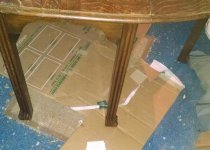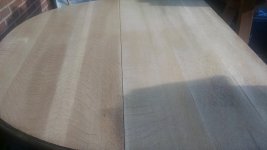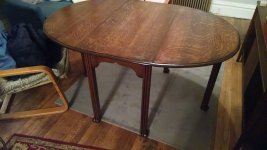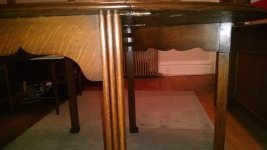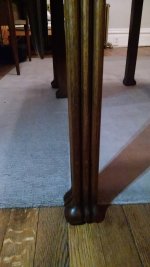I picked up an Ro150 a couple of weeks ago, and I'm delighted by it. It is clean, efficient, more comfortable than my Bosch ROS, and it does an excellent job. I used it to help my parent's refinish an old blanket chest last weekend that had layers and layers of finishes on it - it saved a lot of time, as they had previously spent about 6 hours just working at stripping the top.
I figured that I might want to find another project to play around with and get comfortable using it. The relatively quick gratification of refinishing doesn't hurt, either.
I found a nice solid oak table and picked it up for very little money. It has a fair amount of damage to the finish and some water damage on the top, but nothing too crazy. A couple opening in the joints that will need to be filled. The base is much cleaner, although I will need to disassemble and reglue.
Here is the top:
View attachment 1
A picture of the legs -- it's a gate-leg drop-leaf style table.
View attachment 2
And here's the top taken from 40 - 80 in Rotex mode. 8)
View attachment 3
I'm in the process of bleaching the top, which has some green/black staining from water.
I haven't been able to identify the table in any way. The previous owner told me he bought it at an antique shop in Portland, Oregon.
The species and finish make me think it's inspired by Mission style, but the bottom is attached to the top with pre-kreg pocket holes, and the screws all appear to be modern.
At the same time, the base is held together using a combination of some very rough mortise and tenon joints as well as dowels. The dowels were glued in with hide glue.
The legs are a mystery to me. The only thing I found that came close was an old english table with a much more ornately carved top.
If anyone has any ideas, I'd be very interested. I spent a year studying violin makers, and I always enjoyed the professor's explanations of the various factors that distinguished one era/region/maker from another.
-Adam
I figured that I might want to find another project to play around with and get comfortable using it. The relatively quick gratification of refinishing doesn't hurt, either.
I found a nice solid oak table and picked it up for very little money. It has a fair amount of damage to the finish and some water damage on the top, but nothing too crazy. A couple opening in the joints that will need to be filled. The base is much cleaner, although I will need to disassemble and reglue.
Here is the top:
View attachment 1
A picture of the legs -- it's a gate-leg drop-leaf style table.
View attachment 2
And here's the top taken from 40 - 80 in Rotex mode. 8)
View attachment 3
I'm in the process of bleaching the top, which has some green/black staining from water.
I haven't been able to identify the table in any way. The previous owner told me he bought it at an antique shop in Portland, Oregon.
The species and finish make me think it's inspired by Mission style, but the bottom is attached to the top with pre-kreg pocket holes, and the screws all appear to be modern.
At the same time, the base is held together using a combination of some very rough mortise and tenon joints as well as dowels. The dowels were glued in with hide glue.
The legs are a mystery to me. The only thing I found that came close was an old english table with a much more ornately carved top.
If anyone has any ideas, I'd be very interested. I spent a year studying violin makers, and I always enjoyed the professor's explanations of the various factors that distinguished one era/region/maker from another.
-Adam


